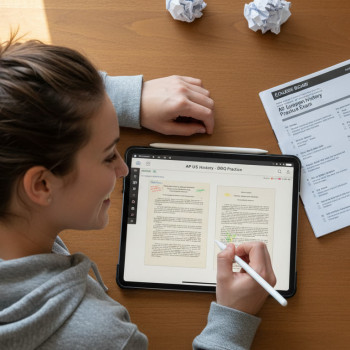Introduction — Why Portfolio Theme Choices Matter
When you sit down to plan an AP portfolio—whether for AP Studio Art (2-D Design, 3-D Design, or Drawing), AP Research, or even a collection of AP course projects—you’re making a strategic choice that will influence how teachers, college admissions counselors, and scholarship committees interpret your work. The two big moves you can make are to pursue depth (one idea explored deeply) or breadth (many ideas explored across varied work). Each path communicates something different about you as a student and creator.

The Core Differences: Depth vs Breadth
Before you commit, it helps to define the two approaches in plain language.
Depth: The Power of Focus
Depth means you select a central theme, problem, or technique and explore it through multiple pieces or projects. This approach values refinement, iteration, and clear development over time. In AP contexts, depth demonstrates research skills, sustained inquiry, and technical mastery.
Breadth: The Strength of Range
Breadth means you show a wide range of skills, genres, or topics. Think of a sampler platter: you reveal versatility, adaptability, and curiosity. In AP portfolios, breadth can highlight interdisciplinary thinking and your ability to succeed across different formats.
How Colleges and Evaluators Read Portfolios
Understanding the audience is crucial. Evaluators—whether AP readers, teachers grading a portfolio, or college admissions readers—are looking for evidence of learning, growth, and intellectual personality. Here’s what your approach signals:
- Depth signals: persistence, mastery, capacity for longer projects, willingness to iterate and reflect.
- Breadth signals: curiosity, flexibility, rapid skill acquisition, multidisciplinary thinking.
Neither signal is intrinsically better. The best choice aligns with your strengths, the subject, and your goals.
Practical Checklist: When to Choose Depth
- You have a compelling central idea you care about for months or years.
- Your subject benefits from layered development (e.g., a photography series, repeated experiments, or an evolving research question).
- You want to show growth over time and the ability to refine methods or compositions.
- You’ll be judged on technical mastery or methodological rigor.
Practical Checklist: When to Choose Breadth
- You’re still exploring different interests and want to show range.
- Your portfolio spans multiple mediums or AP subjects (for instance, AP Computer Science and AP Studio Art projects) and you want to illustrate interdisciplinary strengths.
- You’re highlighting adaptability, quick learning, or leadership across contexts.
- You don’t have one clear passion yet but want to show strong capabilities in many areas.
Hybrid Strategies — Best of Both Worlds
You don’t have to choose extremes. A hybrid portfolio gives space for both a focused core and supporting variety. For example:
- Start with a deep central sequence (4–6 pieces) that shows development, followed by 2–4 supplementary works that highlight different techniques or contexts.
- In AP Research, present one deep study plus two mini-studies or pilot explorations that demonstrate broader inquiry skills.
This hybrid plan is especially useful if you’re aiming to show mastery while still proving versatility.
Real-World Examples: What Depth and Breadth Look Like
Concrete examples make the choices less abstract. Here are sample portfolio outlines for different AP contexts.
| AP Context | Depth Example | Breadth Example |
|---|---|---|
| AP Studio Art | A photography series exploring urban isolation across seasons (12 works showing evolving technique and concept). | 12 works across portraiture, landscape, still life, and mixed-media collage to show stylistic range. |
| AP Research | A single longitudinal project analyzing sleep and cognitive performance in teens with iterative measures and reflections. | Three smaller studies on sleep, nutrition, and time management showing comparative inquiry skills. |
| AP Computer Science Principles | One app built and iterated with user testing logs and code evolution documented. | Four small projects: a website, a data visualization, a small game, and a script showing diverse applications. |
How to Decide: A Step-by-Step Decision Framework
Follow these steps to land on the strategy that fits you.
Step 1 — Inventory Your Work
List everything you have: pieces, projects, drafts, research notes, images. Don’t self-edit yet. Quantity breeds clarity.
Step 2 — Identify Threads
Look for recurring motifs, techniques, questions, or skills. If a clear thread appears, depth becomes attractive. If you see many strong but disconnected pieces, breadth might be truer to your record.
Step 3 — Ask the Audience Question
Who will see the portfolio and why? AP readers are often assessing learning outcomes and a sustained inquiry. College readers might want to know what you’ll bring to campus. Align your approach with that audience.
Step 4 — Prototype a Structure
Mock up two outlines (depth-focused and breadth-focused). Compare which version tells a clearer story about you.
Step 5 — Seek Feedback
Get feedback from teachers, mentors, or a tutoring service that offers 1-on-1 guidance. A fresh pair of eyes often spots narrative gaps you miss.
Common Pitfalls and How to Avoid Them
- Overstuffing: Don’t fill your portfolio with mediocre pieces to demonstrate breadth—quality beats quantity.
- Unexplained Evolution: If you choose depth, document the process. Iterations and reflections are evidence of thoughtful practice.
- Mismatched Goals: If college applications emphasize interdisciplinary work, a purely narrow portfolio may miss the mark.
- Neglecting Presentation: Good organization and concise captions or reflections can make a modest portfolio feel professional and cohesive.
How to Structure Your Portfolio Narrative
Whether you choose depth, breadth, or hybrid, the story matters. Here’s a simple structural formula you can adapt:
- Opening Statement: 1–2 sentences that set your theme or central inquiry.
- Evidence Block: The main works grouped logically (by sequence for depth, by category for breadth).
- Reflection Entries: Short captions that explain purpose, methods, and what you learned.
- Process Documentation: If applicable, include drafts, tests, or reflection notes that show growth.
- Closing Reflection: A final note on future directions or how the work shaped you.
Table: Quick Pros and Cons for Student Reference
| Approach | Pros | Cons |
|---|---|---|
| Depth | Shows mastery, growth, and commitment. | May seem narrow if not contextualized. |
| Breadth | Highlights versatility and cross-disciplinary skills. | Can feel scattered without a unifying thread. |
| Hybrid | Balances focus with variety and often fits most applicants. | Requires careful curation to avoid dilution. |
Examples of Strong Captions and Reflections
Captions are small but mighty. They transform a collection of things into a coherent narrative. Below are sample captions for each approach.
- Depth Caption: “Iteration 4 of my urban lighting series. After testing exposure and lens choices across three seasons, I focused on high-contrast composition to emphasize isolation. I learned how framing and shadow interplay with narrative intent.”
- Breadth Caption: “Portrait study using charcoal. I experimented with cross-hatching to capture texture; this piece complements my digital portrait series by showing a different approach to tone and line.”
- Hybrid Caption: “Core project: community mapping of food access (see first four figures). Supplement: a short interview collection with local vendors that provides qualitative context to the data.”
How to Use Tutoring and Personalized Support Effectively
Getting outside help is not cheating—it’s strategic. Personalized tutoring (like Sparkl’s personalized tutoring and benefits) can accelerate your reflection, help you choose the strongest works, and craft captions that hit the right notes. Here’s how to use such support well:
- Ask for a critical review of your portfolio draft, focusing on coherence and evidence of growth.
- Request mock evaluations where tutors review your narrative as if they were AP readers or admissions officers.
- Use tailored study plans to strengthen weaker technical skills you want to include in the portfolio.
- Leverage 1-on-1 guidance to develop your final reflection and to rehearse talking points for interviews or portfolio reviews.
Timeline: Build Your Portfolio Without Last-Minute Panic
Start early. A timeline keeps depth projects from feeling rushed and ensures breadth portfolios include polished work. Here’s a practical schedule for a school-year project:
- Months 1–2: Inventory and brainstorming. Identify themes and gather raw materials.
- Months 3–5: Focused production phase. For depth, iterate. For breadth, produce and refine multiple pieces.
- Months 6–7: Peer and mentor review. Revise according to feedback.
- Month 8: Final edits, captions, and presentation polish.
Presentation Tips — Digital and Physical
Your presentation format affects how your portfolio reads. For digital submissions, optimize image files, use concise captions, and ensure responsive layout. For physical displays, pay attention to lighting, labels, and consistent mounting. A few fast rules:
- Use high-quality images and consistent color correction for visual work.
- Keep captions short—clarity over flourish.
- Sequence pieces intentionally; every placement should feel deliberate.

Final Checklist Before Submission
Run through this checklist in the days before you submit:
- Does the portfolio tell a coherent story about you?
- Are the pieces high quality and well-documented?
- Have you included process work or reflections for depth projects?
- Is file naming and resolution appropriate for the submission platform?
- Did you get at least two outside reviews (teacher, mentor, or tutor)?
Closing Thoughts — Making the Choice That Fits You
Choosing depth or breadth is a personal decision, not a one-size-fits-all rule. Depth shows what you can do when you commit; breadth shows what you can do when you explore. The clearest, most persuasive portfolios are honest: they play to your strengths, document the thinking behind the work, and present a confident narrative.
If you feel stuck, use small experiments: prototype a depth sequence and a breadth sampler, then get feedback. And if you want structured support—whether that’s feedback on sequencing, help building captions, or a tailored study plan to shore up weaker areas—personalized tutoring like Sparkl’s one-on-one guidance and AI-driven insights can save time and sharpen your presentation. The right help can turn a good portfolio into a memorable one.
A Final Tip: Trust the Process
Your portfolio is more than an application artifact—it’s a record of how you think, create, and grow. Treat it as a conversation with the reader. Be curious. Be honest. And remember: a thoughtfully curated portfolio, whether deep, broad, or hybrid, reflects your unique academic voice.
Good luck—this is your chance to make your work speak for you.



















No Comments
Leave a comment Cancel